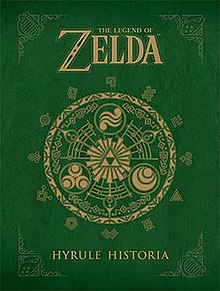
The Legend of Zelda is an action-adventure game franchise created by the Japanese game designers Shigeru Miyamoto and Takashi Tezuka. It is primarily developed and published by Nintendo, although some portable installments and re-releases have been outsourced to Flagship, Vanpool, and Grezzo. The gameplay incorporates action-adventure and elements of action RPG games.
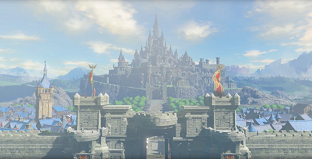
The Legend of Zelda is a video game franchise created by Japanese video game designers Shigeru Miyamoto and Takashi Tezuka. It is mainly developed and published by Nintendo. The universe of the Legend of Zelda series consists of a variety of lands, the most predominant being Hyrule. The franchise is set within a fantasy world that is reminiscent of medieval Europe and consists of several recurring locations, races and creatures. The most prominent population in the series are the Hylians, a humanoid race with elfin features, that are identifiable by their long, pointed ears. The game world is accompanied by a detailed fictional lore that contains a creation myth, several constructed languages, the most prominent being Hylian, and a fictional universal currency called the rupee. Most games in The Legend of Zelda series follow a similar storyline, which involves the protagonist Link battling monsters to save Princess Zelda and defeat an evil villain, which is often the series' main antagonist, Ganon. Nintendo developed the fictional lore into a complex timeline that spans across the series and chronicles thousands of years of fictional history.

The Legend of Zelda: A Link to the Past is an action-adventure game developed and published by Nintendo for the Super Nintendo Entertainment System. It is the third game in The Legend of Zelda series and was released in 1991 in Japan and 1992 in North America and Europe.

The Triforce is a fictional artifact and icon of Nintendo's The Legend of Zelda series of video games. It first appeared in the original 1986 action-adventure game The Legend of Zelda and is a focus of subsequent games in the series, including The Adventure of Link, A Link to the Past, Ocarina of Time, Oracle of Ages, Oracle of Seasons, The Wind Waker, Skyward Sword, and A Link Between Worlds. The Triforce consists of three equilateral triangles, which are joined to form a large equilateral triangle. In the fictional history of the series, it represents the essence of the Golden Goddesses named Din, Nayru and Farore who create the realm of Hyrule and is able to grant godlike power to the character who holds all three pieces. The Triforce also represents the three main characters of the series, Ganon, Zelda and Link, and their inherent qualities in the battle between good and evil. Due to its prominence and significance within the mythology of the Zelda series, the Triforce has become a widely recognisable symbol in gaming.

Princess Zelda is the titular character in Nintendo's The Legend of Zelda video game series. She was created by Shigeru Miyamoto and introduced in the original 1986 game The Legend of Zelda. She is one of the central characters in the series, having appeared in multiple incarnations over more than three decades. In the fictional storyline of the series, she is an elf-like Hylian princess of the kingdom of Hyrule, an associate of the protagonist Link, and bearer of the Triforce of Wisdom.
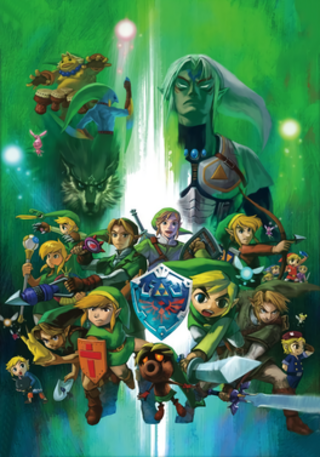
Link is a fictional character and the protagonist of Nintendo's video game franchise The Legend of Zelda. He was created by Japanese video game designer Shigeru Miyamoto. Link was introduced as the hero of the original 1986 The Legend of Zelda video game and has appeared in a total of 20 entries in the series, as well as a number of spin-offs. Common elements in the series include Link travelling through Hyrule whilst exploring dungeons, battling creatures and solving puzzles until he eventually defeats the series' primary antagonist, Ganon, and saves Princess Zelda.

Ganon is a fictional character and the primary antagonist of Nintendo's The Legend of Zelda video game series and franchise, as well as the final boss in many Zelda titles. A massive and malevolent creature, he first appeared in the original game, The Legend of Zelda (1986), and has since appeared in the majority of the games in the series. Ganon is the archenemy of the protagonist Link and originally the leader of the Gerudo, a race of humanoid desert nomads before becoming the ruler of his demons. In his original Gerudo form, from which he can change magically, he is known as Ganondorf.

The Legend of Zelda: Four Swords Adventures is an action-adventure video game developed and published by Nintendo for the GameCube. It is the eleventh installment in The Legend of Zelda series. It was released in 2004 in Japan on March 18, and in North America on June 7. In 2005, the game was released in Europe on January 7, and in Australia on April 7. The Game Boy Advance handheld game console can be used as a controller when using the GameCube – Game Boy Advance link cable bundled with the game in North America and Europe.

The Master Sword is a fictional divine magic sword in Nintendo's The Legend of Zelda series. It is also known as "The Blade of Evil's Bane", the "Sword of Resurrection", the "Sword that Seals the Darkness", and the "Sacred Sword". It was introduced in the 1991 action-adventure video game The Legend of Zelda: A Link to the Past and has since appeared in numerous other games in the series. The sword is the signature weapon of the hero, Link and has become an integral part of the character's visual identity and destiny in Zelda mythology. In the narrative of the Zelda series, it is a powerful, sacred weapon that Link repeatedly uses to defeat the main antagonist, Ganon and other forces of evil. Throughout the Zelda series, it is shown to have various magical powers, including the capability to repel evil, alter the flow of time and emit light beams to attack surrounding enemies. In addition to The Legend of Zelda series, the Master Sword has also appeared in various other video games, media and merchandise, including Super Smash Bros., Mario Kart 8 and Hyrule Warriors. It has been recreated in fan art, cosplay and weaponry and has become a widely recognisable image in video gaming.

Midna is a fictional character introduced as one of the main protagonists in Twilight Princess, a 2006 video game in Nintendo's The Legend of Zelda series. She is a member of the magic-wielding Twili who joins forces with Link to prevent the kingdom of Hyrule from being enveloped by a corrupted parallel dimension known as the Twilight Realm. While Midna appears as an imp-like creature in the majority of Twilight Princess, her actual form is humanoid. She was designed by Yusuke Nakano and voiced by Akiko Kōmoto. Midna's first appearance was in a trailer for Twilight Princess shown at the 2005 Electronic Entertainment Expo (E3); at the time, her gender was unknown, leaving some journalists confused about it.
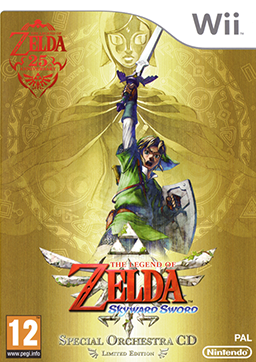
The Legend of Zelda: Skyward Sword is an action-adventure game developed and published by Nintendo for the Wii in November 2011. A high-definition remaster of the game, The Legend of Zelda: Skyward Sword HD, was co-developed by Tantalus Media and released for the Nintendo Switch in July 2021.

Fi is a fictional character in The Legend of Zelda series. She appears in Skyward Sword and its 2021 HD remaster. Fi is a major character in the storyline and is the guide and companion to the protagonist, Link. She is a spirit that inhabits the sword that Link uses during gameplay, which eventually transforms into the Master Sword. Her main function is to provide hints and advice to the player. Fi received a mixed reception from both critics and gamers who considered her repeated interjections to be annoying and excessive. Her dialogue was significantly reduced as part of various improvements to the remastered Skyward Sword HD. She also appears as a playable character in the 2014 spin-off game Hyrule Warriors and as a Spirit in the 2018 fighting game Super Smash Bros. Ultimate.
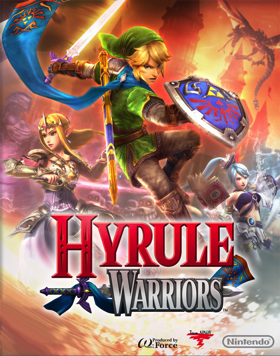
Hyrule Warriors is a hack and slash video game developed by Omega Force and Team Ninja for the Wii U video game console. The game is a collaboration between Koei Tecmo and Nintendo, mixing settings and characters from Nintendo's The Legend of Zelda with the gameplay of Koei's Dynasty Warriors series. Hyrule Warriors was released in Japan in August 2014, and worldwide the following month. It became one of the best-selling games on the Wii U. An updated port, Hyrule Warriors Legends, was released for the Nintendo 3DS in Japan in January 2016 and worldwide in March of the same year. A second enhanced port, Hyrule Warriors: Definitive Edition, was released for the Nintendo Switch in 2018. A successor, Hyrule Warriors: Age of Calamity, was released exclusively for the Nintendo Switch in November 2020.

The Legend of Zelda is a high-fantasy video game series created by Japanese game designers Shigeru Miyamoto and Takashi Tezuka. It is primarily developed and published by Nintendo, although some portable installments have been outsourced to Capcom, Vanpool and Grezzo. The series' gameplay incorporates elements of action, adventure and puzzle-solving games.
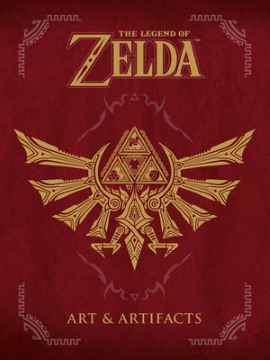
The Legend of Zelda: Art & Artifacts is an art collection book about Nintendo's The Legend of Zelda video game series. It is published in English by Dark Horse Comics out of a partnership with Nintendo and is the second book of an official series called the "Goddess Trilogy" that began with the publication of Hyrule Historia and was completed with the publication of The Legend of Zelda Encyclopedia. It was released on 26 February 2017 to celebrate the 30th anniversary of The Legend of Zelda series. The book provides a collection of illustrations created in the first 30 years of The Legend of Zelda video games. Two editions were published including a standard edition with a red cover and a purple limited edition that depicts the Master Sword on its cover.

Impa is a recurring fictional character in Nintendo's The Legend of Zelda series. She is one of the oldest and most frequently recurring characters in the series, having appeared in six titles of The Legend of Zelda games and several spin-off games. She has been redesigned in a variety of forms over the years, but her role has always been to take care of Princess Zelda either as a nursemaid or guardian, and act as a guide to the hero, Link. Impa is also a member of the Sheikah, a mysterious ninja-like group in the lore of the series that is skilled in combat and magic. She first appeared in the instruction manual for the original 1986 action-adventure video game The Legend of Zelda, then made her debut as a major character in the 1998 action-adventure game Ocarina of Time. She has since appeared in several titles in The Legend of Zelda series, including Oracle of Seasons and Oracle of Ages, Skyward Sword, A Link Between Worlds and Breath of the Wild. She also appears in several spin-off games, including Hyrule Warriors and Cadence of Hyrule. Her most recent appearance was in Hyrule Warriors: Age of Calamity in 2020. Impa has received a positive reception for her representation as a strong female character and also for her role in the narrative and lore of the Zelda series.

The Legend of Zelda Encyclopedia is a book about Nintendo's The Legend of Zelda video game series. It is published in English by Dark Horse Comics and is the third book in the "Goddess Collection" trilogy, following the publication of Hyrule Historia and Art & Artifacts. The encyclopedia was released to celebrate the 30th anniversary of The Legend of Zelda series. It provides a detailed compendium of the numerous fictional characters, creatures and items found within the first 30 years of the Zelda game series. It was published as a standard edition with a blue cover and a deluxe edition with a gold NES cartridge design in June 2018.

The Legend of Zelda: Breath of the Wild – Creating a Champion is a companion art book to Nintendo's 2017 video game The Legend of Zelda: Breath of the Wild. It was published in English by Dark Horse Comics on 20 November 2018 and is a localisation of a book titled Master Works that was published by Nintendo in Japan. It presents official illustrations and concept art from the game alongside development notes and also documents the fictional history of Hyrule presented in the game. The book was released as a standard edition with a white cover, a "Hero's Edition" featuring a blue cloth slip case and a "Champion's Edition" collector's box with a leather case.
